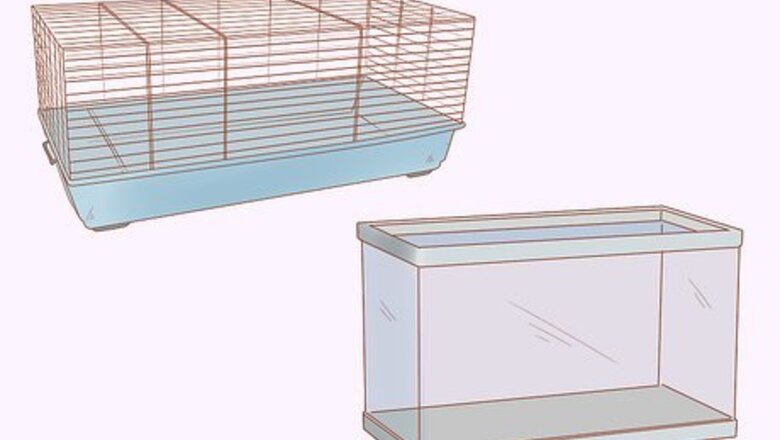
views
X
Research source
Making a Home for Your Hamster
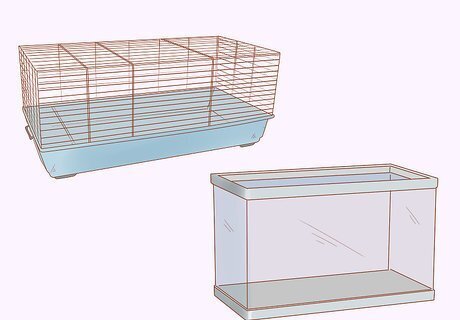
Pick out a hamster cage. Dwarf hamsters are only around 4 inches long, but they like having a lot of space to run around and play (the absolute bare minimum is 600 square inches). The cage should be big enough to give the hamster room to move around in addition to holding the hamster's food, water, and toys. Choose from the following housing options: A hamster aquarium. Buy a special aquarium made for hamsters or choose one designed for fish, which will do just as well. Glass aquariums protect hamsters from cold, drafty temperatures, and they provide an excellent view of the hamster's daily activities. The aquarium should have a mesh cover on top so the hamster can't escape. A plastic hamster home. These expensive hamster cages usually have several rooms connected with plastic tubing, so the hamster can spend his days and nights running from room to room. They are hard to clean and usually way too small for hamsters. Even by connecting several critter trails (or similar cages) together your hamster will not be happy as it does not have a big running space and you can not fit a lot into these cages. Additionally, they are hard to assemble and are usually not tall enough to add big wheels or enough bedding. A wire hamster cage. Especially when your hamster is a baby, make sure that it cannot squeeze through the wires. Hamster cages make a comfortable home for hamsters. These cages are well ventilated, but you have to be careful not to put your hamster in a drafty area. The area around wire hamster cages can get a little messy, since hamsters like to dig in their bedding and pitch it through the wire. Make sure NOT to get a wire cage with a wire bottom. It can hurt your hamster's feet. However, most wire cages sold by pet stores are way too small for hamsters., The best hamster cage is the biggest you can reasonably afford. The RSPCA recommend that the minimum size of cage for a Syrian hamster should be 75cm x 40 cm x 40 cm. (29 ½ inches x 15 ¾ inches x 15 ¾ inches). A great cage is the IKEA Detolf as it provides the hamster with a lot of space and allows you to easily see your hamster. It is also affordable for its size. Another recommendation for a wire cage is the Alexander hamster cage by Skyline. It allows enough space for toys, wooden tunnels and more, however, it may be hard to fit a wheel big enough for a Syrian hamster. The cage also may be too small for very active hamsters, depending on how much they like to run around. If you notice your hamster chewing the bars, you may need to switch to a bigger cage.
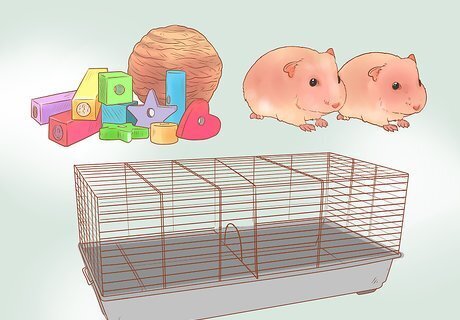
Keep a single hamster alone in a cage. If you want multiple hamsters, do not put them in the same enclosure. There are a lot of people who say hamsters are social creatures, but studies have shown hamsters are actually solitary and could fight to the death with another hamster when given the chance. So if you want to make your hamster happy do not assume its social. Even in the wild a female hamster will chase a male hamster out of her territory when the breeding is done.
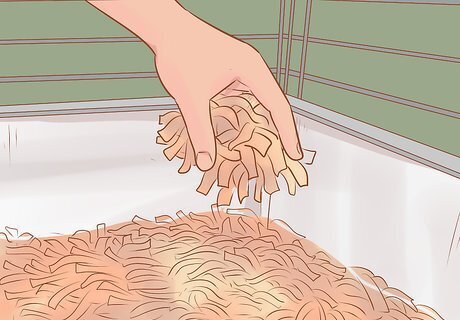
Buy hamster bedding. Dry bedding is essential for the health of a dwarf hamster. It keeps moisture away from the hamster's body and provides shelter and warmth. Choose bedding made of recycled paper, wood pulp, or recycled corncobs. Also make sure you provide a lot of burrowing space for your hamster to dig in. Ideally, you would have at least 15cm of bedding in at least one area. Make sure the bedding you use does not contain pine or cedar shavings. Pine and cedar contain phenols that are toxic to hamsters, since the fumes they produce are so strong. Some hamsters are allergic to certain types of bedding. If your bedding contains pine, cedar, or another allergen, he may start wheezing and sneezing. If you see this happen, switch the bedding to recycled paper or another hypoallergenic bedding. Never ever give your hamster cotton type bedding. It is very dangerous and can kill them. Hamsters cannot digest the cotton fibres in their digestive tract causing blockages. It also presents a choking hazard to your pets.
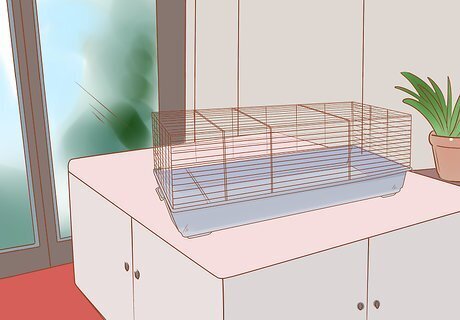
Think about cage placement. Set up the hamster's cage and accessories in a comfortable room. Since hamsters are nocturnal, they should be placed in a room that gets dark at night. Make sure the room is a comfortable temperature that veers toward the warm side, since your hamster can catch pneumonia if it gets too cold. Don't leave windows open in the room where the hamster lives. If you have other pets, make sure the hamster is an area where he won't be disturbed or threatened.

Clean the cage often. A clean cage will help keep your hamster healthy. Scoop out the dirty bedding every 3 weeks, and wash the entire cage once a month. Spot clean every second day, removing bedding covered in urine and feces. Cleaning too often can stress your hamster and shorten its lifespan, as you are removing all familiar scents and moving its habitat around. In general, a medium spray bottle filled with 2 tbs of bleach or antibacterial dish soap and water will have the cleaning power to disinfect the cage without being too dangerous for your hamster. You can also use a white vinegar to clean the cage. Be sure to wipe down your hamster's toys, dishes, and exercise wheel too, but wait at least a week after washing your hamster's cage, so that the hamster has time to get accustomed to the new smells of his freshly cleaned cage. After cleaning, let the cage air dry for 10-15 minutes before you add 3-8 inches of new fresh bedding. 3-8 inches is the recommended amount. Remember that your dwarf hamster is a great burrower. If you don't give your hamster something to burrow in, it won't be as happy. While you are cleaning the cage, make sure you put your hamster somewhere safe, so he doesn't escape. Place him in a hamster playpen or a dry bathtub. Avoid placing the hamster in a cardboard box while he waits for you to clean his cage. Hamsters can chew through cardboard quickly.
Providing Water and Food
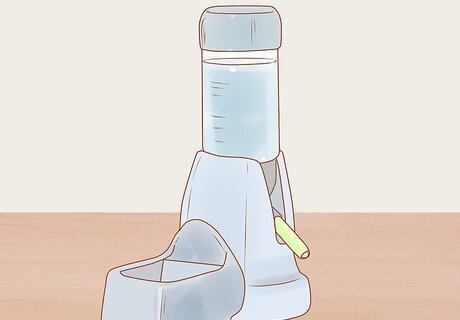
Buy your hamster a water bottle. Many hamster cages come with food and water dishes, but if yours doesn't, you'll have to buy your own. Hamsters drink water through bottles with a metal dispenser. Fill the water bottle with fresh water as it runs out. Don't let the water sit in the bottle for too long. If your hamster is slow to drink, refill the bottle a few times a week, and clean the bottle every now and then. Make sure the bottle doesn't leak. Your hamster can get sick if it gets wet, which is why they take their water through a bottle instead of an open container. You may also put a water bottle outside your enclosure because if your hamster escapes, he will search for water. If he does not get enough water, he'll become very weak.

Buy hamster food. Serve your dwarf hamster food in a shallow plastic dish. This enables hamsters to access the food easily while keeping the cage clean. Hamsters like to nibble food all the time, so the food dish should be kept stocked with fresh food. Throw it out if it gets wet. Pet food stores sell a range of food for hamsters and most of it falls into the following categories: Fortified pellets or blocks, which should be the hamster's staple diet. Seed mixtures meant for hamsters, which may be added as a supplement. Hamsters also need to eat protein like meal worms (dried or alive), crickets etc.

Buy chew sticks. Dwarf hamster teeth grow long and sharp. Your hamster needs something tough to chew on to keep its teeth at a comfortable length. Buy chew sticks or another tough chew toy meant for dulling hamster's teeth.

Give your hamster treats. In addition to pellets and seeds, hamsters enjoy treats every once in a while. Vegetables, few fruits, and other fresh foods may be added to the hamster's diet in small doses. Be sure not to give your hamster too much, since you don't want him to have an upset stomach. Since hamsters are prone to diabetes, fruits should be not be used often and in small amounts when they are, in fact, given. Hamsters can have small bits of lettuce, carrots, apples, broccoli, and tomatoes. Your dwarf hamster will also eat oats, cooked meat, and plain yogurt. Avoid acidic and citrus fruits and vegetables. Avoid giving your hamster citrus fruits or sugar, which can make a hamster ill. Peanut butter is another food to avoid feeding your hamster, as it can choke on it.
Playing With Your Dwarf Hamster
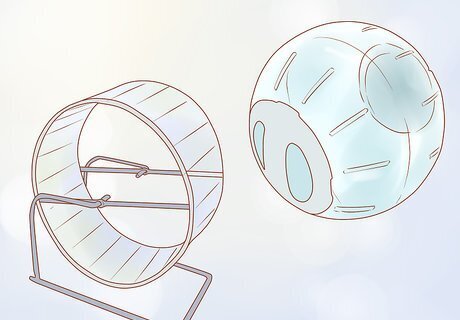
Provide toys and sources of entertainment. Your hamster will have a lot of energy and it'll like to exercise, especially at night. Provide your hamster with toys it can use with or without your help. Exercise wheels are the classic hamster toy. Make sure the wheel is stabilized at the bottom of the cage so it doesn't tip over when the hamster climbs on. Don't choose a wire wheel or your hamster can hurt its feet. The wheel should be big enough that the hamster won't bend its back while it runs on it. Hamster wheels can also be loud, so if you are a light sleeper, put your hamster's cage in a different room. Quiet wheels, usually marketed as silent spinners, are available. For Roborovski Dwarf hamsters the minimum wheel size is 5 inches (13 cm), and for Russian Dwarves (Djungarian/Winter White and Campbell's) and Roborovski hamsters, the minimum is 6.5 inches (17 cm). An alternative to exercise wheels are "flying saucers." They are basically just wheels turned sideways to allow for a flat running surface and quiet rotation. These are dangerous as it makes it very easy for hamsters to fall off and potentially injure themselves. Exercise balls are another popular choice. The hamster is placed inside a plastic ball, which rolls as the hamster runs around. Do NOT buy such a ball. The hamster is very susceptible to stress. They often panic in these balls and can hurt themselves if they run into objects.
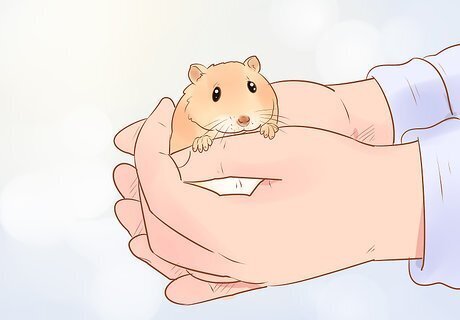
Hold him correctly. In the first few days of getting a new dwarf hamster, do not attempt to pick it up. Just put your hand in its cage and let it sniff you to get used to your scent. Don't grab or otherwise roughly handle your hamster, since it has a very fragile body. Always pick a hamster up from the bottom or else it will feel threatened. Start off by sitting on the floor and holding it near the floor. If it senses an easy escape route, it'll be less likely to bite or squirm. Hold your hamster every day. If your dwarf hamster doesn't socialize frequently, it may stop being as friendly when you want to play. Gently lift your hamster from his cage and let him scurry around your lap at least once a day.
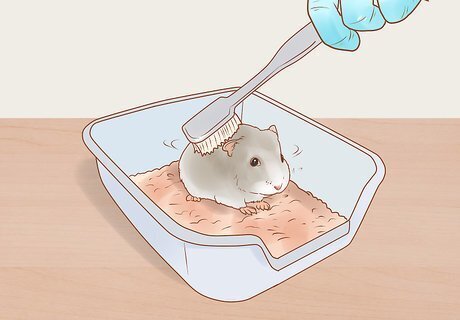
Help your hamster stay clean. Dwarf hamsters are very clean animals and rarely need intervention from their owners to maintain good hygiene. However, once a week you can pour some small animal sand into a bowl and allow your hamster to take a sand bath, which imitates the type of substance hamsters use to keep clean in the wild. If your hamster is very dirty, get a small brush that humans use to dye their hair roots or a toothbrush. Wet it and gently stroke your hamster with it. Dab dry with a rag. Never bathe a hamster by submerging it in water. This will cause the hamster to become very ill.
Keeping Your Dwarf Hamster Healthy
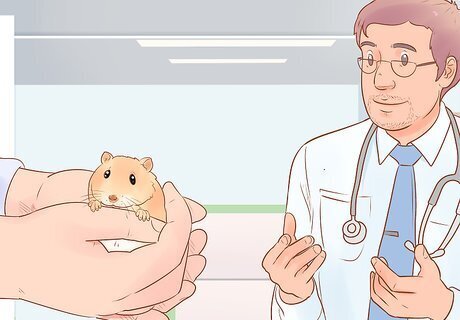
Identify a healthy dwarf hamster. In general, dwarf hamsters have thickset bodies, large cheek pouches, and short tails. Make sure it does not have any nasal or eye discharge, nor any other signs of illness. Russian dwarf hamsters are particularly prone to diabetes. A hamster suffering from this condition will drink a lot of water and urinate more frequently than other dwarf hamsters. Be sure to consult your veterinarian if you suspect that your hamster has diabetes.
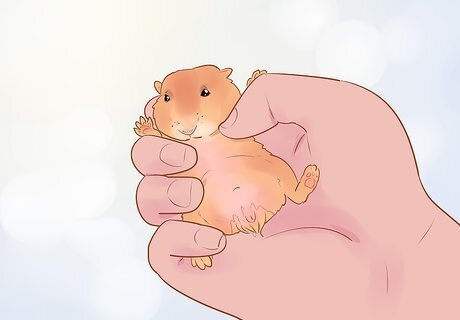
Check for wet tail. A recently weaned or an extremely stressed out dwarf hamster may come down with a disease called “wet tail.” Your hamster experiences diarrhea — the excessive moisture from this causes its tail to become literally wet. Consult a veterinarian for a proper diagnosis and treatment. Tyzzer's disease causes diarrhea in young or stressed hamsters. This is a disease that needs veterinarian treatment. Certain antibiotics can cause and exacerbate this condition, so don't treat your hamster on your own.

Look for signs of parasites. Like dogs and cats, dwarf hamsters can suffer from parasites like tapeworms. Tapeworms are the most predominant, so be on the look out. When you clean out your hamster's cage, be on the lookout for signs of diarrhea and little white rice-like worm segments. If you suspect that your dwarf hamster has a tapeworm, see a veterinarian. Bring a stool sample with you. With the help of a microscope, your vet will be able to properly diagnose your hamster. Your vet will prescribe a dewormer for you to use. It will come in either a topical or an oral form. Follow the instructions on the product in order to administer.
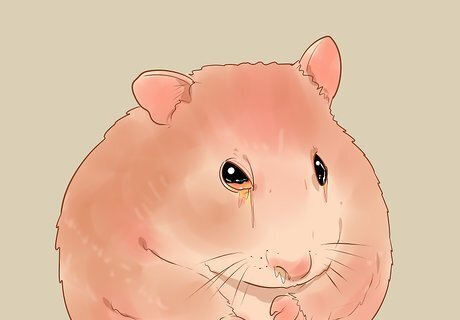
Check their eyes and nose regularly. Dwarf hamsters are susceptible to cold viruses just like humans. Occasionally, this can escalate to pneumonia. A dwarf hamster with pneumonia will have eye and nasal discharge. It will also stop eating. This is serious. Call your veterinarian immediately.
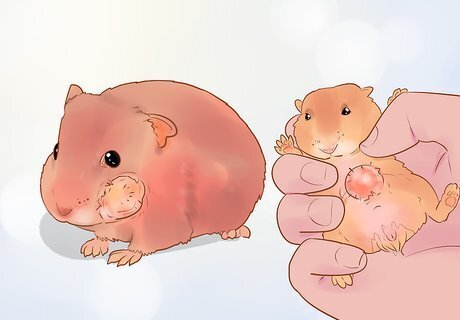
Look for abscesses too. Dwarf hamsters are prone to abscess formation as well, often caused by their teeth. This is most common around their head and cheek pouch areas. Abscesses are essentially infected pockets of puss that will appear underneath your hamster's skin and fur. If present, they will be sensitive to touch. Your hamster will resist your inspection. Contact your veterinarian about how you should proceed. In many cases, the abscess will heal on its own, but if it gets too bad, your vet will probably have to lance and treat the spot.

















Comments
0 comment